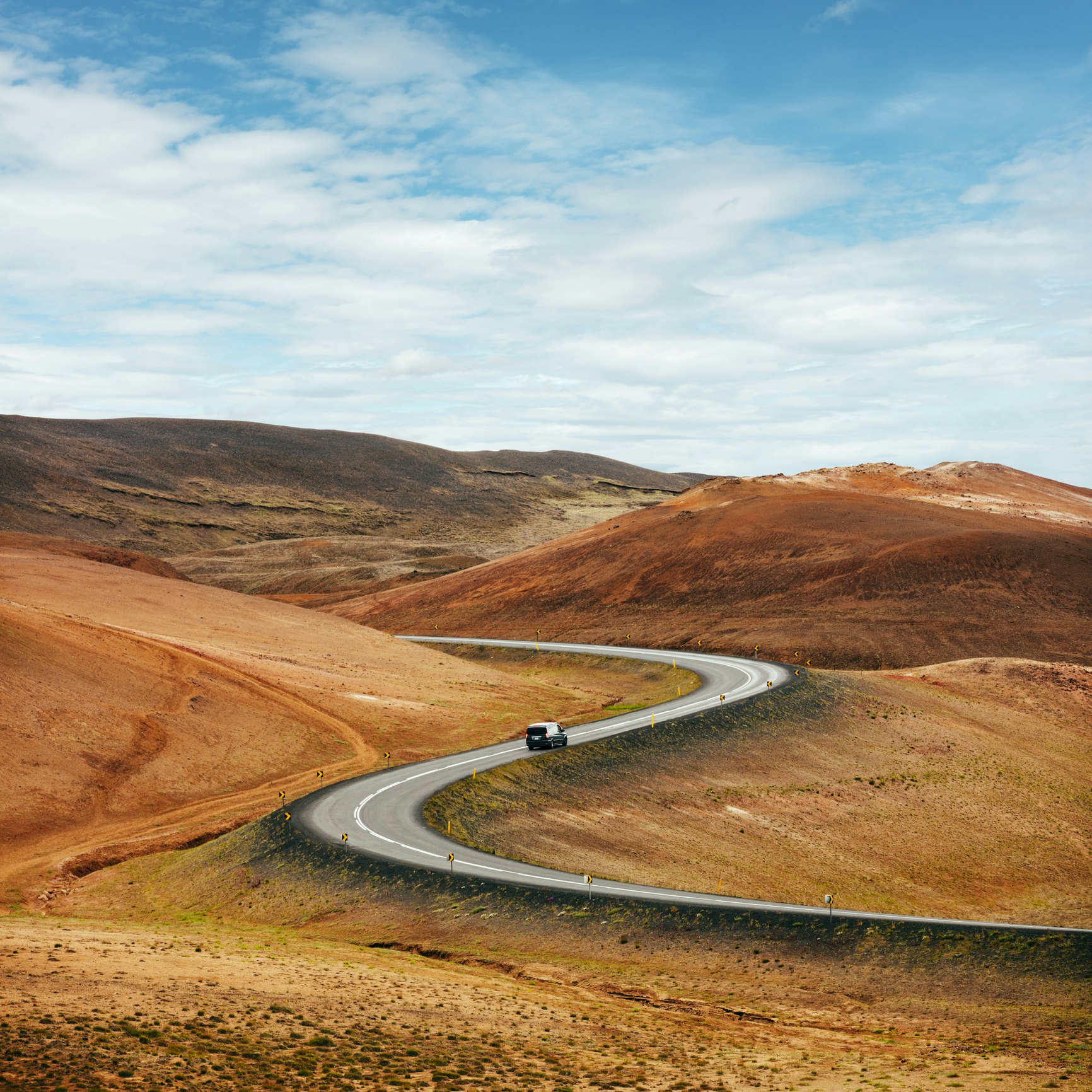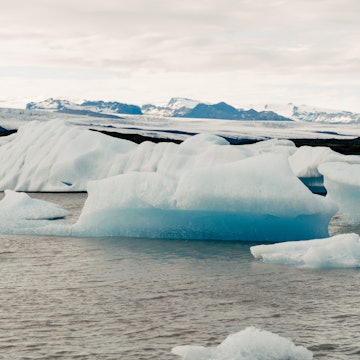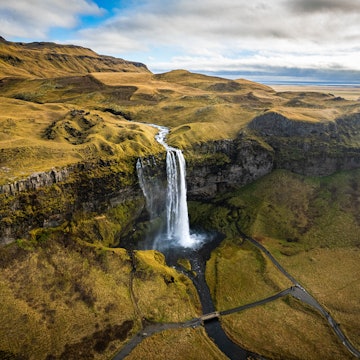
A practical guide to living your best vanlife in Iceland: campers, routes and rules

Jan 5, 2022 • 7 min read

These tips for traveling around Iceland in a van can help you live your best #vanlife © Klaus Vedfelt / Getty Images
Traveling to Iceland is hotter than ever, and it’s not just because of 2021’s volcanic eruption. The land of fire and ice is a magical island nation with stunning waterfalls, rich culture and customs, and gas station hot dogs worth the trans-oceanic trip alone (yes, we mean it), so it’s no surprise that as flights become more available, everyone is looking to check Iceland off their bucket list.
As #vanlife has grown beyond a trend into a dedicated travel style, getting around Iceland via camper is also growing in popularity; it’s an excellent destination for road-tripping and camping. Iceland is also notoriously expensive, but camping is an inexpensive alternative that also enables visiting parts of the country often unseen by those who stick to Reykjavik and its nearby sights.
Here’s how to plan your #vanlife trip to Iceland.
Choose a camper van that’s right for you
When choosing your camper van, it’s essential to keep a few considerations in mind. First, what season are you traveling in? Summer travelers can find comfort with the barest of accouterments (though it’s always important to pack for inclement weather in Iceland), while off-season or winter travelers will want to consider things like a heating system, extra blankets and winter tires.
Next, how many people are joining you? The typical small, entry-level van is enough to comfortably fit two adults and their luggage, but any more traveling companions and you’ll need to splurge for more room. The largest vans usually don’t seat or sleep more than five adults.
Lastly, what are your driving skills or abilities? Manual transmissions are more common in Iceland than they are in the US, and often automatic transmissions are more expensive. Further, if you’re planning to drive into the Highlands or along any of the designated “F” roads, you’ll need a camper equipped with 4WD, which can add to cost and complexity.

Where to find a camper van rental
This is not a comprehensive list of camper rental companies to consider, but these are the most popular and best-reviewed. It’s wise to purchase insurance, as Icelandic roads, weather, and geologic features can be temperamental.
Happy Campers is Iceland’s first-ever camper rental company. It's family-owned and has a great track record for having reliable vehicles, as well as an emphasis on being eco-friendly, planting one tree for every camper that’s booked. The vehicles range from mid-size vans that sleep two to large vans that sleep five. Manual and automatic transmissions are both available, and amenities like sleeping bags, barbecues, and camp chairs can be added on separately.
Kuku Campers is Iceland’s largest camper van rental company, with vehicles sleeping two to five people and ranging from manual to automatic transmission. Amenities like sleeping mats, portable toilets and acoustic guitars can be rented at an extra fee. A bonus of Kuku is that its fleet includes vehicles with rooftop tents, an alternative to bringing or renting one.
Campervan Iceland rents out not only camper vans, but motorhomes as well. Its vans range from standard to large, while the motorhomes come in various sizes as well, and can sleep up to six people. Renting with Campervan Iceland also includes sleeping bags, chairs, and cooking equipment, among other amenities. There are only a few items that need to be brought or rented in addition to the vehicle.
Don’t go overboard on the extras
Most campers are tight, meaning space for amenities comes at the cost of space for passengers. The priority when camping in Iceland is to stay warm. If the camper does not come with sleeping bags, be sure to bring or rent them, as well as extra blankets. If you’ll be cooking, grab a stove, grill, utensils, table and camp chairs. And although you won’t be going off road, renting a safety kit can help in an emergency.

What you need to know once you're on the road
Meals: from grocery stores to gas stations
Renting a stove and buying provisions at grocery stores like Bónus (look out for their logo of a wild-eyed pig) is a cost-effective way to eat in Iceland, and often the only option at the more remote campgrounds. Otherwise, most towns have at least one restaurant, and all the gas stations sell Iceland’s famous hot dogs, as well as a selection of produce and snacks.
Routes: rental companies can help you plan your way
Most road-trippers will encircle the country on the Ring Road while going in and out of the Westfjords’ numerous peninsulas is a close second. Go Campers has a guide to driving and camping in that specific region. Otherwise, Kuku Campers suggests a few routes for your road trip, a helpful planning tool while selecting which campsites to book. And Happy Campers has a trip planning guide that can help you figure out your Iceland camping trip based on if you want to visit during winter, go to places requiring 4WD, or want to see the top attractions.
Gas: plan fuel stops in advance
Iceland may seem little, but what’s truly small is its population of 350,000. More than half of this number live in Reykjavik, meaning it’s possible to drive great distances between villages and towns – sometimes up to 150 miles apart on the Ring Road. Gas stations are not prevalent in empty areas of the country, so it’s important to plan your gas station stops with that in mind: remember that half-full means empty in Iceland. Fuel prices are always in flux but expect to pay roughly ISK 203–235 per liter (roughly $6–7 per gallon).

Driving in Iceland: road rules and conditions
Iceland does a great job of maintaining its roads, at least the parts that are paved. There are still plenty of areas where gravel and dirt make up the roads, which can be tricky to navigate. This is especially so when strong weather hits, which in Iceland tends to be every five minutes (or so the local joke goes).
Driving carefully is essential given the unpredictable weather, and also because of the country’s resident sheep that roam about unfenced during the summer. Hitting them is an unfortunate accident that does happen, and if it does, there is protocol to follow. Search for the sheep’s owner by checking its ear tag, find that rancher, and make sure they are compensated for their loss.
When it comes to passing cars, however, wait for the driver in front of you to indicate to the right that the way ahead is clear. It’s likely only Icelanders will do this, and not other tourists, but the locals will surely appreciate their custom being picked up by visitors. They also ask that drivers not pull off the road (or worse, the middle of the road) for photos or to check a map. Instead, wait for a designated shoulder or turn-off to do so.
There are lots of toll tunnels, one-way bridges, and seasonally accessible roads called F-Roads, so be ready for anything. Be sure to scrutinize signs, as the strong weather can change road availability, and download the 112 app for emergency assistance including getting lost. The allure of Iceland is often in its remote emptiness, but that’s not as fun when you’re accidentally stuck there.
You might also like: 8 unforgettable road trips in Iceland

How to find the perfect campsite
Campers are legally obligated to pitch their tents in designated campsites, except in the Highlands where wild camping is permitted. Do not pitch a tent on private property or you could feel the wrath of an angry Icelander, which is not recommended. It’s much easier to browse Happy Campers guide to camping in Iceland, including the addresses of every campsite in the country. Rent.is, another camper rental company in Iceland, also shares an updated map on their site.
Each campsite is unique when it comes to price, rules, timing, and size. Some have facilities like kitchens, wi-fi or hot springs, while others are more pared down. Campingcard is €159 (around $180) option giving campers access to over 40 designated campsites without having to book in advance or pay an individual fee upon arrival.
Westfjords, Iceland, is on our 2022 Best of Travel list. For more stories from some of the world’s most exciting destinations click here.
Safety recommendations and restrictions during a pandemic can change rapidly. Lonely Planet recommends that travelers always check with local authorities for up-to-date guidance before traveling during Covid-19.
You might also like:
The hidden costs of #vanlife
In Iceland’s remote Westfjords region, a new bicycle route takes shape
Why you should check out these magical Icelandic beaches















